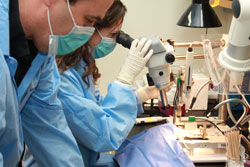URMC / Labs / Pröschel Lab / Prospective Students
Prospective Students
Graduate Program Affiliations
Hands-on, in-depth training
The lab utilizes a wide variety of techniques to manipulate neural cell populations in vitro, and to measure the effect of cell therapeutic interventions in animal models of CNS disease. Besides the commonplace molecular methods (QPCR, Western blot, cloning, lentiviral gene delivery, etc), we have specialized protocols for the isolation and culture of different neural cell populations, including fetal and post-natal neurons, glial precursors, neural stem cells and inducible pluripotent stem cells (iPSCs) and hESCs. Chemically defined culture conditions are used to grow cells, and induce the directed differentiation of precursors. These in vitro methods allowing us to study the behavior and functions of these cells in culture, and to generate specific cell populations for transplantation into the injured CNS. For this purpose we use several different injury models, in particular rodent models of spinal cord injury, and Parkinsonian neurodegeneration.

Functional readouts include common tests of motor skills (Footplacement, forepaw usage, gaitscan, grip strength, pellet reaching), as well as sensory assays (Hargraves, von Frey) and electrophysiological measures (EEG, MEP, SSEP). Post-mortem analysis uses immunohistology and stereological analysis of tissue sections. Because of the large number of techniques, students and post-docs are strongly encouraged to collaborate. However, to ensure a firm grasp of experimental design, and a sound foundation in methodological experience, PhD students are expected to master all the methodologies required to address their specific project needs, ranging from cloning to in vivo work. Projects available to rotation students can include any of these methods, typically however do not involve surgical procedures. All rotation students will be expected to give a brief presentation at the start and end of their rotation. The first presentation is intended to introduce them and their project to the lab. This ensures students have understood the theoretical background of their project and that they can quickly integrate into the lab. The second presentation will take place at the end of the rotation and will include data presentation and Q & A. An overview of research projects can be found here.
Research Opportunities